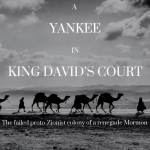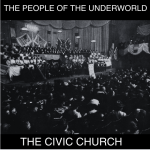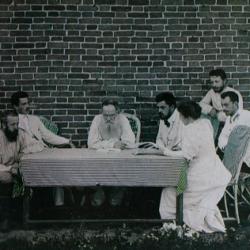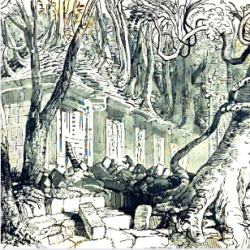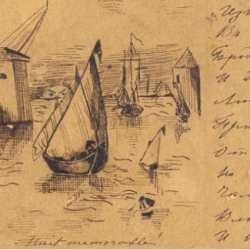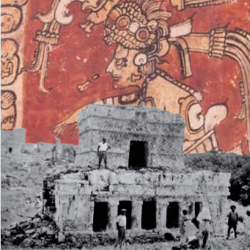WHERE VISHNU SLUMBERS IN HIS SEA-GIRT SHRINE
ACT III.
VI.
⸻
“That so great a mind could not have taken in that splendid teaching of the Sages…” Olcott sighed.[1] He was recounting the story of his meeting with Max Müller to Charley and Ragunath Row, Baroness Kroumess, and Verochka. Joining them was Noguchi Zenshirō, a representative for a committee of Japanese Buddhists, who arrived in Adyar on December 3, 1888, with an invitation for Olcott to lecture in Japan.[2]
“There are very few students of Eastern things who have not felt the charm and fascination with which Müller has invested the subject of the old Indian hymns,” said Charley. “But for all the charm that Müller weaves into his researches…it is very generally felt that the hymns of the Rig Veda are less, very much less, than is claimed for them.”[3]
“As regards Müller’s certain remarks,” said Ragunath Row, “I have already his own explanation, viz., ‘We must not despair even where their words seem meaningless and their ideas barren or wild. What seems at first childish may at a happier moment disclose a sublime simplicity, and even in helpless expressions we may recognize aspirations after some high and noble ideal.’ It will be seen that there is no difference of opinion between me and Professor Müller regarding the character of the Vedas.”[4]
The foundation of the conversation was twofold. The first was Müller’s recent Gifford Lectures, the second was Ragunath Row’s work, A Simple Catechism of the Aryan Religion (1887,) which was still being discussed in the press. A debate between Ragunath Row and Reverend Guilford had taken up an impressive amount of real estate in The Madras Weekly Mail.[5]
“For expounding the Aryan Religion as I have done,” continued Ragunath Row, “I am looked upon by warm of my countrymen as a heterodox Aryan, but they are tolerant to me,” said Ragunath Row. “They would have been intolerant to me if I had adopted new dress and new food,” he added with a smile. “Many of my own relatives are opposed to me and feel convinced that I deserve punishment for my heterodoxy. I have not on that account deserted them. I have lived with, and among them, openly contended with their Guru, and preached and practiced my own views in his very presence and neighborhood. The Guru himself was not intolerant to me and gave me the first seat at dinner with him, although he admitted that he had excommunicated me for my heterodox conduct. When one of our best men, Lord Ripon, gave up the Protestant Church for that of Rome, what did his best friend Mr. Gladstone call him? A pervert!! It may be in the recollection of many how his appointment to the Viceroyalty of India was attacked on the ground of its ‘perversion’ to the Church of Home! Many a Christian brother told me that he would treat me, a heathen, as I according to him, as a brother, but not so such perverts, as they are surely to be into everlasting fire—and that I might be saved, but such ‘perverts’ would never be saved. All this for a change one section of Christianity to another! It is true that such intolerance should not exist under any system called religion, but this world has not yet seen any religionist entirely free from such intolerance.”[6]
“What’s this?” said Olcott, abruptly. “We have visitors.”
~
The guests, the Theosophists would soon learn, was none other than Victor and Margaret Child-Villiers (Lord and Lady of Jersey) whom they met on board the Arcadia. As Margaret and Victor approached, they quickly noticed Olcott and the others sitting in the verandah, and though it was evident that the Theosophists saw them from their elevation, it did not seem as if they had realized that they, too, could be seen from below.
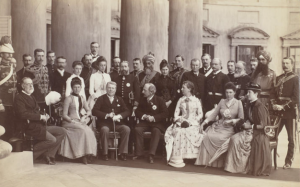
Front row (left to right): Sir Steuart Bayley; Lady Dufferin; Robert Bourke (Lord Connemara); The Viceroy of India, Marquess of Dufferin, Susan Bourke (Lady Connemara); Lady Helen Blackwood and Lady Eva Wyndham Quin c. 1888 (Royal Collection Trust)
After arriving in India, Margaret and Victor stayed as guests of Robert Bourke (Lord Connemara,) the Governor of Madras. Robert had just returned from his tour on the Western Coast. (Ragunath Row was among those on the platform of Central Station in Madras.)[7] Robert’s wife, Susan Ramsay (Lady Connemara,) however, was not with him when he returned to Madras. She arrived at their home, the Government House, soon after Victor and Margaret arrived, accompanied by Dr. Briggs, and one of the staff.[8] It seemed Susan had been in Ootacamund attending the boat races with Dr. Briggs, who performed admirably in the regatta.[9] Susan, the daughter of the marquess of Dalhousie, married Robert in November 1863. Until 1886, they lived primarily in England, moving to Madras when Robert was appointed to the governorship. The day after Susan arrived, just as a large dinner-party arrived at Government House, she mysteriously left for the Albany Hotel, about a half a mile away.[10] Robert implored Victor and Margaret to remain as his guests while Susan was away, and to help him look after his guests. They had to conceal her absence on plea of indisposition. Rumors were swirling, the Bombay Gazette even reporting that society in Madras was much exercised by occurrences in high life, “which have recalled attention in an exceedingly painful way to the question discussed in Mrs. Mona Caird’s paper.”[11] The worst of the news did not reach the wider public, not initially at least. “Fortunately the native servants could not speak English,” Margaret would later write, “and the better class natives in the city behaved extraordinarily well in wishing to keep things quiet as far as possible.”[12]
Susan, it would later be revealed, had caught Robert having an affair with their servant, Hannah Moore. What Susan did not know, but no doubt suspected, was that Robert had infected her a with a syphilitic disease of the tongue—which Robert had contracted in Turkey several years earlier.[13]
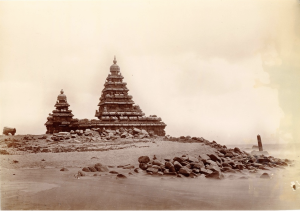
The Seven Pagodas, Shore Temple (Royal Asiatic Society)
The delay was rather tiresome for Victor and Margaret, as they had planned to on arriving in Calcutta well before Christmas. On the other hand, however, it enabled them to see a good deal more in Madras. Just before arriving at Adyar, Robert, Victor, and Margaret, went to the Seven Pagodas, where they were the first to occupy the new Public Works Bungalow. Margaret was even the first to sign the title page for the new Bungalow guest book, which she did with an original poetic composition: “Where Vishnu slumbers in his sea-girt shrine, And Shiva o’er his dusky race bears away, Sleeps on the lake the lotus flower divine, Whose petals hold the pink and parting day.”[14] It was due to this extra time in Madras, that Margaret and Victor were allowed to take Olcott up on his invitation on the Arcadia.
When Margaret and Victor arrived at the door at Adyar, everyone had disappeared except for Olcott, who was sitting with an attitude of abstraction, but jumped up, extending his hands, while expressing his great pleasure at their visit. Olcott took them into a long hall, on which hung the shields of the various Theosophical Lodges in India and the world. There were several rooms, and as Victor and Margaret were shown into them, those whom they saw on the verandah were either “discovered” or “entered” like actors on a stage (and duly introduced.)
“Baroness Kroummess,”— “The Countess of Jersey”
“Mr. Noguchi Zenshirō”—”The Earl of Jersey.”
They were shown the doors of Kathiawar wood, behind which was the Shrine Room, where the paintings of Masters Kuthumi and Morya were kept concealed behind doors reminiscent of a Catholic altarpiece.
“The artist, Schmiechen, painted the Mahatmas without having seen them,” Olcott explained, implying the assistance of divine inspiration. “I intend to have portraits of the Founders of all religions in this Sanctuary,” Olcott continued, “but so far, the only companion of the Mahatmas is a photograph of Paracelsus.”
Just as he had done on the Arcadia, Olcott made an attempt to “convert” Margaret, lending her copies of The Theosophist. “I assure you that our Society is in no sense anti-Christian.”[15]
After tea, Olcott escorted the Earl and Countess along the campus of Adyar, showing them the Library and botanicals on the grounds.[16] They stopped in front of the veranda. “I imported these from Ceylon,” said Olcott, gesturing towards an avenue of golden coconut palms. “They are growing admirably in the damp, hot air of Madras.”[17]
Not long after Margaret and Victor departed, Olcott received a request from Lord Connemara, asking that he be one of the judges at the upcoming exhibition Saidapet Agricultural College, the 300-acre model farm five miles outside of Madras.[18] Olcott agreed, and Charley and Vera were happy to join him.
~
There was not a great many interesting excursions that could be made within an easy distance of Madras, but there was one trip, within the compass of an afternoon drive, that rewarded epicures of scenery, and that was the road to St. Thomas Mount. It was there where the martyred remains of the St. Thomas the Apostle were interred in a half-century-old Roman Catholic Church. (Owing to a recent cyclone, however, the vane on the Church was now slightly out of the perpendicular.)
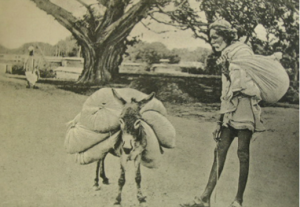
Dhobie (Wikipedia)
Dhobies (washerman) could be seen along the Adyar River, on either side, laboring at their ruthless work of destruction, beating the colorful clothing that was entrusted to them on the stones which protruded from the water. It was a favored place of work for the washerman, flanked as it was by a large expanse of sand which served as a drying ground where they bleached the garments in the tremendous rays of the sun.
The road skirted the grounds of the Saidapet Agricultural College until a little distance from the river, and disfigured by a hideous tower, they reached a handsome building that stood prominently forward with a raised terrace.[19] Madras had long been unfairly known as the “benighted Presidency,” but in no other part of the British Empire was more interest shown in agricultural development. It was a pursuit initiated by the late Sir William Denison when he was Governor of the Madras.[20] Twenty years earlier it was regarded as a “piece of worthless waste land” when it was given for the farm and resembled the island of Malta—the soil of which had to be brought from Sicily.[21] The Saidapet experiment recently proved that milk could be produced at 1 anna per quart, considerably below the cost of milk in England.[22]
~
Most of the students at the Saidapet Agricultural College were the sons of agriculturists who either possessed land, or likely to inherit it, and that most intended to devote themselves to agriculture. Half of the students paid their own way, and the other half were the recipients of scholarships which partly defrayed their expenses. One amongst them delivered an address to Lord Connemara.
“We the students of the Madras College of Agriculture, most respectfully beg to welcome your Excellency to this noble institution, the only one of its kind in all India, founded by your Excellency’s predecessors, a great desideratum in the interests of the agricultural Classes who in this more than any other country, are the mainstay of the Empire. We feel proud that we have an agriculturist for our Governor in the person of your Excellency; and all feel confident that during the administration of such as agriculturist, all due consideration will be accorded to the conditions of the agricultural classes, and to the of the noble branch of industry on which they depend. We trust that this College, yet in its infancy, will, under the of your Excellency and your Excellency’s successors, turn out in the near future to be a potent instrument for ameliorating the condition of the rural population and thus fulfill the laudable object with which it was founded. Before concluding we beg once more to accord your Excellency our most hearty welcome. Wishing long life and continued prosperity to your Excellency and Lady Connemara.”(After several days’ absence, and much negotiation, Susan consented to return.)[23]
“It has given me great pleasure this College this morning,” said Lord Connemara, “and though it would have given me equal pleasure to have seen you all at work on the Farm, I am none the less grateful to you for your kind reception. I am watching with great interest the work which is being done at this Institution; and I am extremely glad to find that very of you are going to take to practical agriculture in after-life and are not merely passing through this course with the view to obtaining Government employment. Those of you who will in after-life put into practice the agricultural knowledge that you have acquired at this College will be of for greater benefit to your fellow creatures than those who merely stud for sake of passing their examinations. I am fortunate this morning in being accompanied by Lord Jersey, the owner of a large property in England. No one is more devoted than Lord Jersey to the welfare of the tenants of his estates, no one better performs the duties of an English country gentleman, and no one will be more glad than he is to see that agriculture is not neglected here.
“A plant cannot thrive without something live upon any more than you can yourselves. In breeding, again, you must remember that no one can breed good stock from bad sires. Similarly, you must sow good seeds if you would have good crop; and I think that the ryots throughout the country probably know what good seed is. As I am about to visit this farm, and inspect its stock, I will say no more now, but I thank you for your reception which does you great credit, since it was only last evening that I signified my intention of paying you this visit.”[24]
Lord Connemara and the party then rode over the farm where Olcott judged a public trial of ploughs.[25]
“Lady Jersey, did you read our publication?” asked Olcott after the event. “I am curious what effect it had on you.”
“I have not only read the magazine, but also its advertisements,” Margaret replied, “which advertised distinctly anti-Christian books.”
Olcott turned the color of beetroot. He had not thought of the advertisements.[26]
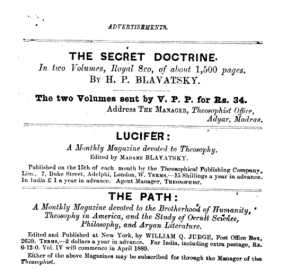
Advertisements in The Theosophist.
~
On December 20, Victor and Margaret were set to depart Madras. John Rees, Lord Connemara was to accompany them to Calcutta, and Robert personally saw to it that they made it safely aboard. Everyone said their tender farewells, and Lord Connemara returned to his boat. Just as soon as he did, Victor and Margaret heard an explosion followed by a fizzing.
A few minutes later the captain appeared on deck.
“Very sorry,” said the captain, “but we cannot start today.”
“What has happened?” asked Margaret.
“The cylinder has blown off.”
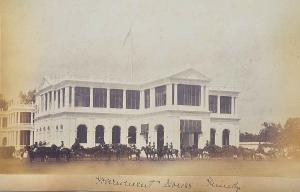
Government House. Madras, India c. 1888. (Past India)
Very much humiliated, Margaret and Victor returned with their luggage to Government House and appeared at what was called “Dignity Ball” in the evening.[27] A “Dignity Ball,” a term derived from the dance hosted by (non-white) West Indians, was a recent importation to Madras.[28] Madras society, already lamenting their “benighted” reputation, feared they would be mocked by the other Presidencies. “In the future,” one paper write, “Madras will do well to demand from each new Governor a written certificate that he and his entourage have not come from Demerara, Kingstown or a Virginian plantation.”[29]
Among the other attendees that evening were Olcott and Noguchi. Lord Connemara, by all accounts, was very pleased to meet Noguchi, and discuss with him the state of religion in Japan, and Olcott’s proposed visit.[30]
In British India, many opportunities were made for balls, dinner parties, and other festive occasions, like picnic excursions under the pretext of “tiger shooting.” There was also the State Ball, the annual balls at the Civil Stations, and the Christmas Ball, but this was sometimes merged into the Station Ball, especially when a number of new ladies were present. The most popular of these events was the February Race Ball, an attractive spectacle for those who had a desire “to see, and to be seen.”[31] A premium was placed on etiquette, and any misstep could have disastrous repercussions in the stratified world of British society. And that is exactly what happened that evening. “It is impossible for me to remain under the same roof with you!” Susan told Robert, abruptly taking her leave of the dance. Accompanied by Captain Quinn (an aide-de-camp,) and Lady Eva Quin, Lady Connemara took up quarters at a local tavern.[32]
← →
THE AGONIZED WOMB OF CONSCIOUSNESS SECTIONS: “ACT III”
I. TOWER HAMLETS.
III. OCCULTISM OF SOUTHERN INDIA.
IV. THE ONE WHO THINKS HE KNOWS.
VI. WHERE VISHNU SLUMBERS IN HIS SEA-GIRT SHRINE.
VII. THE GENERAL IDEA UNDERLYING THE OPERA
VII. THE DECAY OF LYING
SOURCES:
[1] “The President’s Tour.” Supplement To The Theosophist. Vol. X (December 1888): xxvi-xxvii; Müller (née Grenfell,) Georgina Adelaide ed. The Life And Letters Of The Right Honourable Friedrich Max Müller In Two Volumes: Vol. II. Longmans, Green, And Co. London, England. (1902): 234, 294; Olcott, Henry Steel. Old Diary Leaves: Volume III. Theosophical Publishing Society. London, England. (1904): 177-178; Olcott, Henry Steel. Old Diary Leaves: Volume IV. Theosophical Publishing Society. London, England. (1910): 57-58; Child-Villiers, Margaret Elizabeth Leigh. Fifty-One Years Of Victorian Life. John Murray. London, England. (1922): 146.
[2] Olcott, Henry Steel. Old Diary Leaves: Volume IV. Theosophical Publishing Society. London, England. (1910): 71.
[3] Johnston, Charles. “The Culture-Language Of The Future.” The Theosophist. Vol. XIX., No. 3. (December 1897): 146-148.
[4] Row, R. Ragoonatha. “Hinduism And Christianity.” The Madras Weekly Mail. (Madras, India) November 14, 1888.
[5] “Aryanism And Christianity.” The Madras Weekly Mail. (Madras, India) July 21, 1888; Row, R. Ragoonatha. “Education And Evangelisation.” The Madras Weekly Mail. (Madras, India) October 10, 1888; Gulliford, H. “Dewan Ragunatha Rau As A Religious Reformer.” The Madras Weekly Mail. (Madras, India) October 31, 1888; Shortt, John. “Dewan Ragoonatha Row.” The Madras Weekly Mail. (Madras, India) November 14, 1888; Row, R. Ragoonatha. “Hinduism And Christianity.” The Madras Weekly Mail. (Madras, India) November 14, 1888; Gulliford, H. “Dewan Ragunatha Rau As A Religious Reformer.” The Madras Weekly Mail. (Madras, India) November 21, 1888; “Skepticism And Hinduism.” The Madras Weekly Mail. (Madras, India) December 5, 1888; Row, R. Ragoonatha. “The Hindu Attitude Towards Christian Converts.” The Madras Weekly Mail. (Madras, India) December 26, 1888.
[6] R. Ragoonatha Row. “The Hindu Attitude Towards Christian Converts.” The Madras Weekly Mail. (Madras, India) December 26, 1888.
[7] “The Governor’s Return To Madras.” The Madras Weekly Mail. (Madras, India) November 21, 1888.
[8] Child-Villiers, Margaret Elizabeth Leigh. Fifty-One Years Of Victorian Life. John Murray. London, England. (1922): 166.
[9] “The Ootacamund Regatta.” The Madras Weekly Mail. (Madras, India) November 28, 1888.
[10] “Lord And Lady Connemara.” The Civil & Military Gazette. (Lahore, Pakistan) December 13, 1888.
[11] “Lord And Lady Connemara.” The Civil & Military Gazette. (Lahore, Pakistan) December 14, 1888.
[12] Child-Villiers, Margaret Elizabeth Leigh. Fifty-One Years Of Victorian Life. John Murray. London, England. (1922): 166.
[13] “The Connemara Divorce Suit.” The Derby Daily Telegraph. (Derbyshire, England) November 27, 1890; “The Connemara Divorce Suit.” The Manchester Evening News. (Manchester, England) November 27, 1890.
[14] “Notes Of The Week.” The Madras Weekly Mail. (Madras, India) December 5, 1888.
[15] Child-Villiers, Margaret Elizabeth Leigh. Fifty-One Years Of Victorian Life. John Murray. London, England. (1922): 167-169.
[16] Olcott, Henry Steel. “Old Diary Leaves: Fourth Series: Chapter V.” The Theosophist. Vol. XXI, No. 6 (March 1900): 321-331.
[17] Johnston, Charles. “Colonel Olcott At Home” The Theosophical Forum Vol. VI., No. 10. (February 1901): 182-188.
[18] Olcott, Henry Steel. “Old Diary Leaves: Fourth Series: Chapter V.” The Theosophist. Vol. XXI, No. 6 (March 1900): 321-331.
[19] “The Ootacamund Regatta.” The Madras Weekly Mail. (Madras, India) November 28, 1888.
[20] Seton-Karr, W.W. “Indian Agriculture And Our Wheat Supply.” The Asiatic Quarterly Review. Vol. VI (July-October 1888): 45-62.
[21] Murdoch, J. Papers On Indian Reform: Is India Becoming Poorer? The Christian Vernacular Education Society. Madras, India. (1887): 51.
[22] “Dairying In The British Isle And India.” The Madras Weekly Mail. (Madras, India) December 19, 1888.
[23] “Lord And Lady Connemara.” The Civil & Military Gazette. (Lahore, Pakistan) December 13, 1888.
[24] “The Governor At The Saidapet Agricultural College.” The Madras Weekly Mail. (Madras, India) December 5, 1888.
[25] Olcott, Henry Steel. “Old Diary Leaves: Fourth Series: Chapter V.” The Theosophist. Vol. XXI, No. 6 (March 1900): 321-331.
[26] Child-Villiers, Margaret Elizabeth Leigh. Fifty-One Years Of Victorian Life. John Murray. London, England. (1922): 169.
[27] Child-Villiers, Margaret Elizabeth Leigh. Fifty-One Years Of Victorian Life. John Murray. London, England. (1922): 180.
[28] “Odium Cum Dignitate.” Allen’s Indian Mail. (London, England) February 13, 1888; Murray, James A. H (ed.) A New English Dictionary on Historical Principles: Vol. I, Pt. II. J.A. H. Murray. Oxford, England. (1888): 639.
[29] “Madras And ‘Dignity Balls.’” The Civil & Military Gazette. (Lahore, Pakistan) January 17, 1888.
[30] Olcott, Henry Steel. Old Diary Leaves: Volume IV. Theosophical Publishing Society. London, England. (1910): 71-74; “The Gazette Of India.” Civil & Military Gazette. (Lahore, Pakistan) December 27, 1888.
[31] (“An Old Indian”) “Social Life In Bengal Fifty Years Ago.” The Calcutta Review. Vol. LXXIV, No. 147 (1882): 183-192; Jockey Club, S.C. History of the Turf in South Carolina. Russell & Jones. Charleston, South Carolina. (1857): 23-24.
[32] “Around Town.” Toronto Saturday Night. (Toronto, Canada) January 5, 1889.


